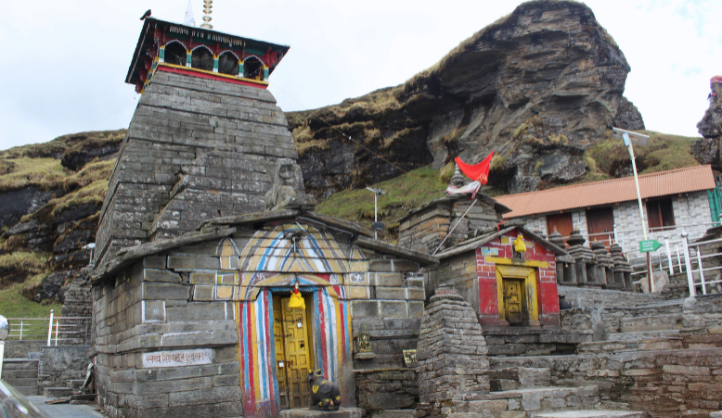Tucked away in the peaceful hills of Chamoli district, Gopeshwar Temple is one of Uttarakhand’s hidden spiritual treasures. Dedicated to Lord Shiva, this ancient temple is known not just for its divine aura, but also for the breathtaking Himalayan views that surround it. The moment you step here, the cool mountain breeze, the sound of temple bells, and the fragrance of incense create an atmosphere that feels far from the rush of everyday life. Whether you are a devotee seeking blessings or a traveler looking for a quiet escape, Gopeshwar Temple offers the perfect mix of faith, history, and natural beauty.
Some interesting facts about the Gopeshwar Temple in Uttarakhand
1. Dedicated to Lord Shiva: Gopeshwar Temple is a revered Hindu temple dedicated to Lord Shiva, the lord of destruction and transformation, making it an important pilgrimage site for devotees.
2. Ancient Heritage: This ancient temple boasts a rich history and architecture that dates back centuries. It reflects the distinctive architectural style prevalent in the Garhwal region.
3. Location: Gopeshwar Temple is situated in the town of Gopeshwar, which is the administrative headquarters of the Chamoli district in Uttarakhand. The temple’s location amidst the picturesque Himalayas adds to its charm.
4. Religious Significance: It is believed that visiting Gopeshwar Temple and seeking the blessings of Lord Shiva here can help devotees attain spiritual enlightenment and cleanse their sins.
5. Festivals: The temple comes alive during the Maha Shivaratri festival when devotees from all over gather to celebrate Lord Shiva. The temple’s premises are adorned with colorful decorations, and special prayers and rituals are conducted.
6. Unique Shivling: Inside the temple, you’ll find a unique Shivling (a symbolic representation of Lord Shiva) that is believed to change colors throughout the day, adding to the mystique of the temple.
7. Idyllic Setting: The serene and tranquil ambiance of Gopeshwar, surrounded by lush greenery and the Himalayan peaks, makes it an ideal place for meditation and introspection.
8. Gateway to Treks: Gopeshwar serves as a gateway to several popular trekking routes, including those leading to Rudranath and Tungnath, offering trekkers stunning views of the Himalayan landscape.
9. Local Culture: While visiting Gopeshwar Temple, you can also immerse yourself in the local Garhwali culture by interacting with the friendly residents and experiencing their customs and traditions.
10. Accessibility: Gopeshwar is well-connected by road to major cities in Uttarakhand, making it relatively accessible for travelers seeking a spiritual and cultural experience in the region.
About Gopeshwar Temple in Uttarakhand
Gopeshwar Temple is a significant Hindu shrine located in the town of Gopeshwar, in the Chamoli district of Uttarakhand, India. This ancient temple is dedicated to Lord Shiva and holds great religious and cultural importance in the region. Here are the key details about Gopeshwar Temple:
1. Spiritual Significance: Gopeshwar Temple is dedicated to Lord Shiva, who is revered as the supreme deity in Hinduism. The temple is considered a sacred place of worship for devotees seeking blessings and spiritual solace.
2. Location: Situated in the scenic town of Gopeshwar, nestled in the Garhwal region of Uttarakhand, the temple is surrounded by the majestic Himalayan mountains, creating a serene and spiritually charged ambiance.
3. Architectural Style: The temple showcases a unique blend of Garhwali and Nagara architectural styles. Its distinctive design features intricate carvings, wooden elements, and a shikhara (tower) that adds to its architectural grandeur.
4. Idyllic Setting: The temple’s picturesque location amidst lush greenery and the snow-capped peaks of the Himalayas provides a tranquil environment for prayer and meditation.
5. Religious Practices: Devotees visit Gopeshwar Temple to offer prayers, perform rituals, and seek the blessings of Lord Shiva. Special ceremonies and aarti (prayer rituals) are conducted regularly.
History of Gopeshwar Temple in Uttarakhand
Understanding the historical context of Gopeshwar Temple sheds light on its evolution and cultural significance over the years:
1. Ancient Origins: The temple’s history dates back centuries, with its roots deeply embedded in the religious traditions of the Garhwal region. It is believed to have been constructed in the medieval period.
2. Religious Significance: Gopeshwar Temple is considered one of the sacred Char Dham temples in Uttarakhand, alongside Badrinath, Kedarnath, and Yamunotri. Pilgrims often include it in their spiritual journey to seek blessings.
3. Cultural Heritage: The temple’s architecture and cultural practices reflect the rich heritage of the Garhwali people. It stands as a symbol of their devotion and reverence for Lord Shiva.
4. Festivals: The temple comes alive during festivals like Maha Shivaratri when elaborate celebrations take place. Devotees throng to the temple to participate in special pujas and seek divine blessings.
5. Preservation: Efforts have been made to preserve and protect the historical and architectural significance of Gopeshwar Temple. Restoration work has been carried out to maintain its structural integrity.
Why is Gopeshwar Temple Famous in Uttarakhand
Gopeshwar Temple in Uttarakhand is renowned for several compelling reasons, making it a significant pilgrimage and cultural site in the region. Here’s why Gopeshwar Temple is famous:
1. Spiritual Significance: Gopeshwar Temple is dedicated to Lord Shiva, one of the principal deities in Hinduism. Devotees visit the temple to seek blessings, perform rituals, and deepen their spiritual connection with the divine.
2. Historical Significance: The temple boasts a rich history that dates back centuries. It is a symbol of the region’s cultural and religious heritage, reflecting a blend of architectural styles prevalent in the Garhwal Himalayas.
3. Char Dham Pilgrimage: Gopeshwar Temple is an integral part of the Char Dham Yatra, a sacred pilgrimage that includes Badrinath, Kedarnath, Yamunotri, and Gangotri. Pilgrims often visit Gopeshwar as they embark on this spiritual journey.
4. Architectural Grandeur: The temple’s unique architectural design, characterized by intricate carvings, wooden elements, and a majestic shikhara (tower), adds to its fame as a magnificent religious structure.
5. Picturesque Location: Nestled amidst the breathtaking Himalayan landscape, Gopeshwar Temple’s idyllic setting enhances the overall experience for visitors, making it an attraction not just for devotees but also for nature enthusiasts and photographers.
Things to Do in Gopeshwar Temple, Uttarakhand
While visiting Gopeshwar Temple, there are several activities and experiences to indulge in:
1. Prayer and Meditation: Participate in the spiritual ambiance of the temple by offering prayers, attending aarti ceremonies, and finding moments of meditation and reflection.
2. Explore the Architecture: Admire the unique architecture of the temple, characterized by its intricate carvings and artistic details that tell a story of the region’s cultural heritage.
3. Attend Festivals: If your visit coincides with festivals like Maha Shivaratri, immerse yourself in the festive atmosphere by witnessing special ceremonies and cultural performances.
4. Scenic Walks: Take leisurely walks in the temple’s surroundings, enjoying the serene beauty of the Himalayan foothills and the lush greenery.
5. Local Culture: Engage with the local Garhwali culture by interacting with residents, learning about their customs, and savoring regional cuisine.
6. Photography: Capture the temple’s architectural beauty and the stunning natural landscapes surrounding it, making memorable photographs.
7. Exploration: Explore the town of Gopeshwar and nearby attractions, including trekking routes and natural wonders like waterfalls and rivers.
Things to Know About Gopeshwar Temple in Uttarakhand
Gopeshwar Temple in Uttarakhand is a place of religious and cultural significance. Here are some important things to know before visiting:
- Spiritual Relevance: Gopeshwar Temple is dedicated to Lord Shiva and holds great spiritual importance for Hindus. It’s part of the Char Dham pilgrimage circuit, making it a significant stop for devotees.
- Architectural Heritage: The temple showcases an architectural blend of Garhwali and Nagara styles. Its intricate carvings, wooden elements, and a towering shikhara (spire) reflect the region’s artistic and cultural heritage.
- Location: Gopeshwar is situated in the Chamoli district of Uttarakhand, amidst the scenic beauty of the Garhwal Himalayas. The temple’s location provides a serene and picturesque setting for prayer and reflection.
- Religious Practices: Devotees visit the temple to offer prayers, perform rituals, and seek Lord Shiva’s blessings. Daily aarti ceremonies and special pujas are conducted, creating a divine atmosphere.
- Historical Significance: Gopeshwar Temple has a history that dates back centuries, reflecting the enduring religious and cultural traditions of the region.
How to Reach Gopeshwar Temple in Uttarakhand
Reaching Gopeshwar Temple is relatively accessible by various modes of transportation:
- By Road: Gopeshwar is well-connected by road to major cities in Uttarakhand, including Rishikesh and Dehradun. State-run buses, as well as private taxis, are available for the journey.
- By Air: The nearest airport is Jolly Grant Airport in Dehradun, approximately 230 kilometers away. From the airport, you can hire a taxi or take a bus to Gopeshwar.
- By Rail: The nearest railway station is Rishikesh Railway Station, located about 209 kilometers from Gopeshwar. From there, you can continue your journey by road.
- Local Transport: Within Gopeshwar, you can explore the town and its surroundings on foot or by hiring local transport, such as rickshaws or taxis.
Travel Tips for Gopeshwar Temple in Uttarakhand
When planning a visit to Gopeshwar Temple, consider these travel tips to make your journey enjoyable and hassle-free:
- Check Weather Conditions: Before your trip, monitor the weather forecast, especially if you plan to visit during the winter months. Uttarakhand experiences cold temperatures and heavy snowfall, which can affect travel plans.
- Accommodation Reservations: Gopeshwar can get crowded during peak pilgrimage seasons. It’s advisable to book your accommodation in advance to ensure a comfortable stay.
- Dress Modestly: When visiting the temple, dress modestly and respectfully. This includes covering your shoulders and knees as a sign of respect for the religious site.
- Local Customs: Be mindful of local customs and traditions. Remove your shoes before entering the temple premises, and show respect for religious practices and rituals.
- Photography: While photography is generally allowed, it’s essential to ask for permission before taking pictures inside the temple. Some areas may have restrictions.
- Cash and ATMs: Carry sufficient cash as ATM availability can be limited in remote areas. It’s a good idea to withdraw cash in major cities before heading to Gopeshwar.
- Altitude Consideration: Gopeshwar is at a moderate altitude, but if you plan to trek to higher altitudes or visit nearby peaks, be aware of altitude sickness. Acclimatize properly and stay hydrated.
- Local Cuisine: Try local Garhwali and Kumaoni cuisine. Gopeshwar and nearby towns offer opportunities to savor regional dishes like Aloo Ke Gutke and Phaanu.
- Pack Accordingly: Depending on the season of your visit, pack accordingly. Winter requires warm clothing, while summer and autumn may need lighter attire. Don’t forget essentials like sunscreen and insect repellent.
Best Time to Visit Gopeshwar Temple in Uttarakhand
The timing of your visit to Gopeshwar Temple can significantly impact your experience. Here’s when it’s best to explore this sacred site:
- Summer (April to June): The best time to visit Gopeshwar is during the summer months when the weather is pleasant, with temperatures ranging from 15°C to 25°C. This period is ideal for pilgrimage and sightseeing.
- Monsoon (July to September): The monsoon season brings heavy rainfall to Uttarakhand, increasing the risk of landslides and road closures. It’s not recommended for travel during this period.
- Autumn (October to November): Autumn offers clear skies and cool weather, making it a good time for a visit. The landscapes are lush after the monsoon, creating a vibrant backdrop for your journey.
- Winter (December to February): Winter provides a unique experience, especially if you want to witness the temple in a snowy setting. However, be prepared for extremely cold temperatures and limited accessibility.
Places to Eat Near Gopeshwar Temple in Uttarakhand
Exploring the local cuisine and dining options near Gopeshwar Temple can be a delightful part of your visit. Here are some eateries and nearby places to satisfy your culinary cravings:
- Gopeshwar Town: Within Gopeshwar itself, you can find local restaurants and eateries serving North Indian and regional Garhwali dishes. These are ideal places to sample traditional Uttarakhand cuisine.
- Chamoli: The nearby town of Chamoli, approximately 10 kilometers from Gopeshwar, offers additional dining options. You can find local dhabas (roadside eateries) and restaurants serving a variety of Indian dishes.
- Joshimath: Located around 45 kilometers away, Joshimath has a more extensive selection of restaurants and cafes. You can enjoy North Indian, Garhwali, and even international cuisine in this town.
- Badrinath: If you plan to extend your trip to Badrinath, approximately 100 kilometers from Gopeshwar, you’ll find a range of dining choices, including restaurants and local eateries.
- Local Delicacies: Don’t miss the opportunity to try regional Garhwali and Kumaoni specialties, such as Aloo Ke Gutke, Chainsoo, and Bal Mithai, which you can often find in these towns.
Nearby Places to Visit in Gopeshwar, Uttarakhand
While in the vicinity of Gopeshwar Temple, there are several nearby attractions and points of interest to explore:
- Anusuya Devi Temple: This temple, dedicated to Goddess Anusuya, is located near Gopeshwar and is known for its serene surroundings and religious significance.
- Tungnath Temple: Tungnath, the highest Shiva temple in the world, is a trekking destination around 10 kilometers from Gopeshwar. It’s famous for its spiritual aura and scenic beauty.
- Chopta: Often referred to as the “Mini Switzerland of Uttarakhand,” Chopta is approximately 30 kilometers away and offers stunning views of the Himalayan peaks. It’s an excellent spot for trekking and nature lovers.
- Deoria Tal: Located about 35 kilometers from Gopeshwar, Deoria Tal is a pristine lake surrounded by lush forests and offers breathtaking reflections of Chaukhamba peaks on its clear waters.
- Ukhimath: Ukhimath, around 40 kilometers from Gopeshwar, is known for its religious significance, trekking opportunities, and serene environment.
Conclusion
In conclusion, the Gopeshwar Temple in Uttarakhand is a place of profound spiritual significance, historical richness, and architectural beauty. Devotees visit this ancient temple to seek blessings from Lord Shiva and immerse themselves in the serene ambiance of the Himalayan foothills. To plan a visit to Gopeshwar Temple, consider the best time to go, adhere to local customs, and explore nearby attractions. Whether you’re a pilgrim or a traveler seeking cultural and natural experiences, Gopeshwar Temple offers a unique journey into the heart of Uttarakhand’s religious and scenic landscape.
Frequently Asked Questions about Gopeshwar Temple in Uttarakhand
1. Why is the Gopeshwar Temple famous in Uttarakhand?
Gopeshwar Temple is famous for its spiritual significance as a sacred place dedicated to Lord Shiva. It is also part of the Char Dham pilgrimage circuit in Uttarakhand.
2. What is the best time to visit Gopeshwar Temple?
The best time to visit Gopeshwar Temple is during the summer months (April to June) for pleasant weather. Autumn (October to November) is also a favorable time with clear skies.
3. How can I reach Gopeshwar Temple in Uttarakhand?
Gopeshwar is accessible by road, with well-connected routes from major cities. The nearest airport is Jolly Grant Airport in Dehradun, and the nearest railway station is Rishikesh Railway Station.
4. What are some nearby attractions to Gopeshwar Temple?
Nearby attractions include Tungnath Temple, Chopta, Deoria Tal, Ukhimath, and Anusuya Devi Temple, each offering unique cultural, natural, and trekking experiences.
5. What should I know about local cuisine near Gopeshwar Temple?
Near Gopeshwar Temple, you can savor local Garhwali and Kumaoni cuisine, featuring dishes like Aloo Ke Gutke, Chainsoo, and Bal Mithai, providing a taste of regional flavors.





